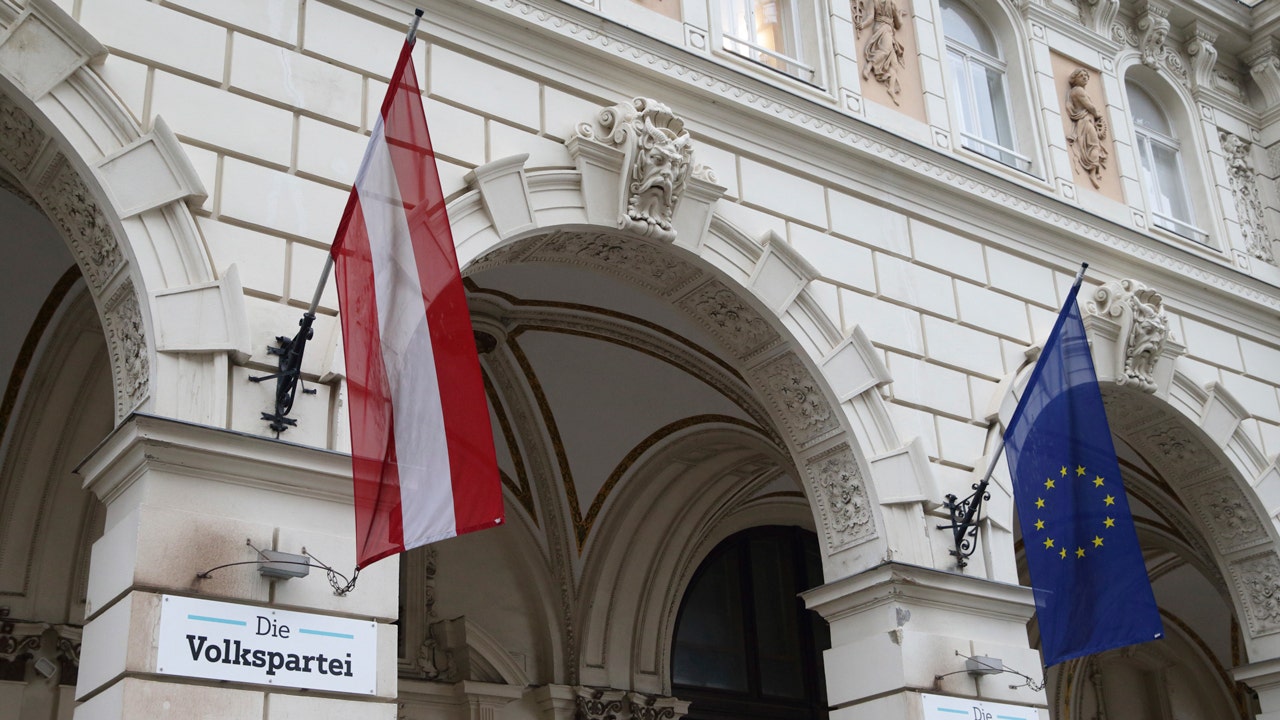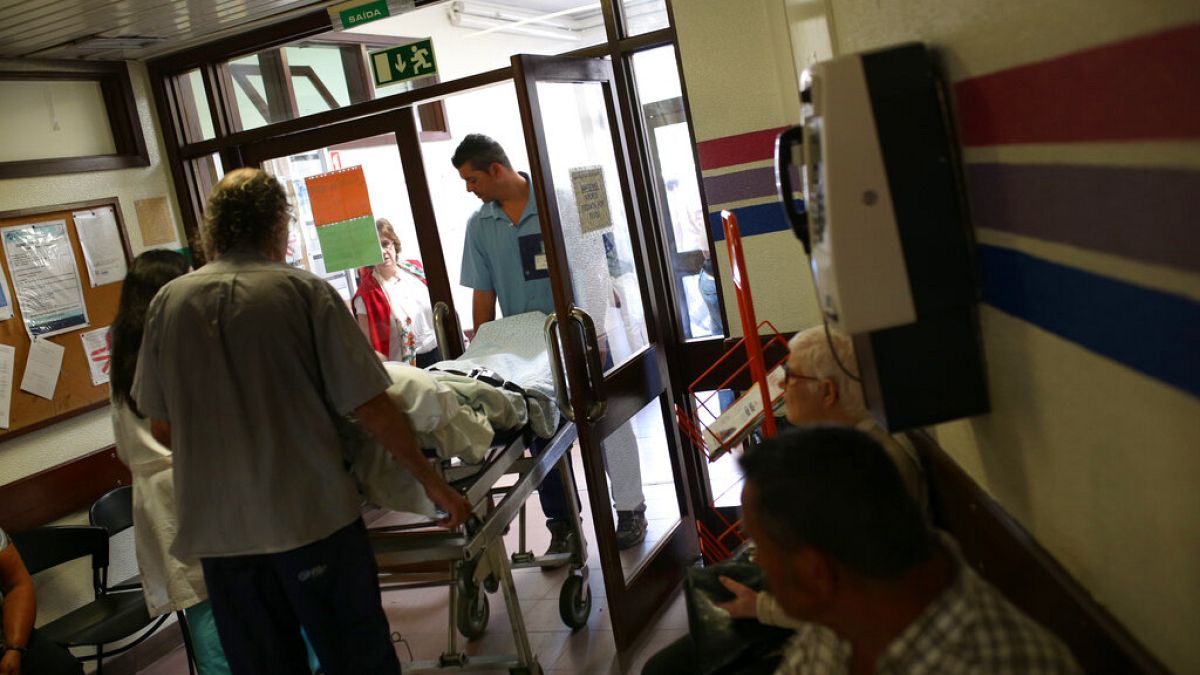World
Austrian nationalist party leader rumored to be in talks to form government

Austrian President Alexander Van der Bellen on Sunday announced that he would meet with far-right politician Herbert Kickl as speculation grows that he will ask the Freedom Party leader to form a government.
Van der Bellen made the announcement after meeting with Chancellor Karl Nehammer and others at his presidential palace. Nehammer has announced his intention to resign after coalition talks between his conservative Austrian People’s Party and the center-left Social Democrats collapsed over the budget.
Nehammer has ruled out working with Kickl, but others within his party are less adamant. Earlier Sunday, the People’s Party nominated its general secretary, Christian Stocker, as interim leader, but the president said Nehammer would remain chancellor for now.
Van der Bellen said that he had spent several hours talking to key officials, after which he got the impression that “the voices within the People’s Party who exclude working with the Freedom Party under its leader Herbert Kickl have become quieter.”
GERMANY ACCUSES ELON MUSK OF TRYING TO INTERFERE IN ITS NATIONAL ELECTIONS
The president said that this development has “potentially opened a new path,” which has prompted him to invite Kickl for a meeting on Monday morning.
Kickl’s Freedom Party topped the polls in the autumn’s national election with 29.2% of the vote, but Van der Bellen tasked Nehammer with putting together a new government because no other party was willing to work with Kickl.
That decision drew heavy criticism from the Freedom Party and its supporters, with Kickl saying in October that it was “not right and not logical” that he did not get a mandate to form a government.
“We are not responsible for the wasted time, the chaotic situation and the enormous breach of trust that has emerged,” Kickl said Sunday afternoon on social media. “On the contrary: It is clear that the Freedom Party has been and continues to be the only stable factor in Austrian politics.”
Exterior view of the Austrian Peoples’ Party’s headquarters in Vienna, Austria, Sunday, Jan. 05, 2025. (AP Photo/Heinz-Peter Bader)
Stocker addressed reporters on Sunday afternoon and confirmed that he had been appointed “unanimously” by his party to serve as interim leader. “I am very honored and happy,” he said.
He also welcomed the decision by the president to meet with Kickl and said that he now expects that the leader of the party that emerged as the clear winner from the last election would be tasked with forming a government.
“If we are invited to negotiations to form a government, we will accept this invitation,” Stocker added.
In the past, Stocker has criticized Kickl, calling him a “security risk” for the country.
In its election program titled “Fortress Austria,” the Freedom Party calls for “remigration of uninvited foreigners,” for achieving a more “homogeneous” nation by tightly controlling borders and suspending the right to asylum via an emergency law.
The Freedom Party also calls for an end to sanctions against Russia, is highly critical of Western military aid to Ukraine and wants to bow out of the European Sky Shield Initiative, a missile defense project launched by Germany. The Freedom Party has also signed a friendship agreement in 2016 with Putin’s United Russia Party that it now claims has expired.
Kickl has criticized “elites” in Brussels and called for some powers to be brought back from the European Union to Austria.
Austria was thrown into political turmoil on Friday after the liberal party Neos pulled out of coalition talks with the the People’s Party and the Social Democrats. On Saturday the two remaining parties, who have only a one-seat majority in Parliament, made another attempt to form a government — but that also ended in failure after a few hours, with negotiators saying they were unable to agree on how to repair the budget deficit.

World
‘We didn’t have anybody there’: Kyiv’s troops struggle as Russia advances

Kyiv, Ukraine – As Ukrainian forces fight in the western Russian region of Kursk, they are encountering a new enemy – elite North Korean servicemen.
On Sunday, Ukrainian infantry and armoured vehicles resumed an offensive in three directions in Kursk, trying to fence their toehold in the district centre of Sudzha that they had seized in August.
By Tuesday, they occupied at least three villages northeast of Sudzha – and inflicted losses on the North Koreans that fight in separate units under Russian command.
“We thinned their ranks – they have losses, although Kim didn’t just send ordinary servicemen,” a Ukrainian soldier told Al Jazeera, referring to North Korean leader Kim Jong Un.
He did not disclose his name, details and exact whereabouts of the battles in accordance with wartime regulations.
South Korean and US officials have said Kim deployed more than 10,000 elite soldiers to Kursk. Hundreds are understood to have been killed there already.
More than 450km (280 miles) south of Kursk, another Ukrainian serviceman keeps repelling waves of Russian infantrymen near the key southeastern city of Pokrovsk.
“Looks like they send a new brigade every day,” the serviceman told Al Jazeera.
Russians keep advancing despite a reported lack of tanks and armoured vehicles.
“They keep pushing. The only problem they have is their equipment, they can’t throw it around the way they did three or four months ago,” he said.
But the biggest problem his unit – as well as all of Ukraine’s armed forces – faces is a dire shortage of manpower.
Last week, Ukrainian troops retreated from the eastern town of Kurakhove, which Russian troops claimed control of on Monday.

Kyiv’s forces have also lost a key coal mine near Pokrovsk and could be about to lose Ukraine’s biggest lithium deposit in Shevchenkove.
“The Kurakhove defence installations have been taken over just because we didn’t have anybody there,” the serviceman said. “The most motivated soldiers have been killed, the new ones lack training and motivation.”
He also cited poor decisions made by commanding officers, alleging they want to appease their superiors and do not value the lives of servicemen.
“I’ve been wounded so many times because of the commanders’ stupidity,” he said.
Russians ‘looting’ in Donetsk town
The Russian forces that seized Kurakhove are looting abandoned apartments, a local woman alleged.
“They’re breaking into apartments that haven’t been damaged by shelling, they steal everything they can carry away,” Olena Basenko, a former sales clerk from Kurakhove who is looking for her elderly aunt who refused to leave the town, told Al Jazeera.
“Some ‘liberators’ they are,” she said sarcastically referring to Moscow’s pledge to “liberate” Ukraine from President Volodymyr Zelenskyy’s “neo-Nazi junta” – Russian claims that have been debunked throughout the war.
Ukraine’s shortage of manpower has led some analysts to doubt Kyiv’s push to resume the Kursk offensive.
“Zelenskyy’s strategy is to amass brigades with equipment in the rear only to solemnly lose them in the land of Kursk to gain 1.5km [1 mile] of farmland,” Nikolay Mitrokhin, a researcher with Germany’s Bremen University, told Al Jazeera.
The units that are advancing in Kursk could instead have been used to defend Kurakhove, he said.
However, others see the Kursk offensive as a chance to gain an important bargaining chip.

Ukraine may try to seize a Russian nuclear power plant in the town of Kurchatov that lies about 70km (45 miles) northeast of Sudzha and could attempt to seize Kursk’s regional capital 30km (20 miles) farther away.
If successful, the takeover of Kurchatov may become a significant strategic gain, according to the former deputy head of Ukraine’s general staff of armed forces.
“We didn’t want to make things worse, but we need to,” Lieutenant General Ihor Romanenko told Al Jazeera.
Kyiv may also invade the nearby Russian region of Bryansk, dealing a heavy blow to Russian President Vladimir Putin’s domestic reputation, he said.
“It will be painful to Putin, and if there is an offensive somewhere in Bryansk or some other regions, it will make him think,” Romanenko said.
Some Russians ridicule Putin’s policies that led to the first foreign invasion of western Russia since World War II.
“If the grandpa from the bunker is so wise, why do we have Ukrainians on Russian land? Something must be wrong,” Roman, a 48-year-old Muscovite who served in a tank unit in the 1990s, told Al Jazeera, deriding the Russian president.

Bryansk borders Ukraine and has been repeatedly attacked by two Ukrainian military units made up of pro-Ukrainian Russian fighters.
Romanenko said Putin’s decision to ramp up Russia’s offensive in southeastern Ukraine signifies a “fiasco” of Trump’s “peace plan”.
“This approach ended with a fiasco because Putin rejected the version proposed by Trump’s team,” he said.
Trump has offered few details of the plan, but, according to his team, it may include the establishment of a “demilitarised zone” along the current front line, Kyiv’s ceding of Russia-occupied areas and a delay of Ukraine’s NATO membership.
Ukraine’s sea drone weapons
At the end of last year, Ukraine scored a small victory that may herald huge losses in Russian navy bases and civilian seaports.
On December 31, Ukrainian sea drones, or un-piloted vessels armed with small missiles, attacked Russian helicopters in the bay of Sevastopol, the main naval base in annexed Crimea.
Ukraine claimed to have shot down two helicopters, killing all 16 crew members.
Moscow acknowledged no losses but said its forces destroyed four Ukrainian unmanned aircraft and two sea drones.
The attack showed that sea drones could wreak havoc on Russian port and naval infrastructure along the Black Sea, Bremen University’s Mitrokhin said.
Furthermore, Kyiv could use sea drones for attacks on the Russian navy in the Baltic, Barents and White Seas and in the Pacific.
“There is so much infrastructure there that it will be hard to cover it even with boom barriers, let alone protect them from all sides like in Sevastopol or [the Crimean port of] Feodosiya,” he said.

Meanwhile, the ongoing war of attrition tests Ukraine and Russia’s economies.
The Russian economy has “partially adapted to the pressure from [Western] sanctions, but it currently enters the inflation shock of overheating and slower growth” because of the Central Bank’s high percentage rates, Kyiv-based analyst Aleksey Kusch said.
The Ukrainian economy is “in shock” because of severely damaged energy infrastructure and a lack of labour force, he said.
But hydrocarbon exports help Russia’s economy recover from the shock, while Ukraine is kept afloat by Western financial aid.
“It creates a certain parity effect amid resistance to war,” Kushch told Al Jazeera.

World
The next round of bitter cold and snow will hit the southern US
ANNAPOLIS, Md. (AP) — The next round of bitter cold was set to envelop the southern U.S. on Tuesday, after the first significant winter storm of the year blasted a huge swath of the country with ice, snow and wind.
The immense storm system brought disruption even to areas of the country that usually escape winter’s wrath, downing trees in some Southern states, threatening a freeze in Florida and causing people in Dallas to dip deep into their wardrobes for hats and gloves.
By early Tuesday, wind chill temperatures could dip into the teens to low-20’s (as low as minus 10.5 C) from Texas across the Gulf Coast, according to the National Weather Service. A low-pressure system is then expected to form as soon as Wednesday near south Texas, bringing the potential of snow to parts of the state that include Dallas, as well as to Oklahoma, Arkansas and Louisiana.
The polar vortex that dipped south over the weekend kept much of the country east of the Rockies in its frigid grip Monday, making many roads treacherous, forcing school closures, and causing widespread power outages and flight cancellations.
Ice and snow blanketed major roads in Kansas, western Nebraska and parts of Indiana, where the National Guard was activated to help stranded motorists. The National Weather Service issued winter storm warnings for Kansas and Missouri, where blizzard conditions brought wind gusts of up to 45 mph (72 kph). The warnings extended to New Jersey into early Tuesday.
A Kentucky truck stop was jammed with big rigs forced off an icy and snow-covered Interstate 75 on Monday just outside Cincinnati. A long haul driver from Los Angeles carrying a load of rugs to Georgia, Michael Taylor said he saw numerous cars and trucks stuck in ditches and was dealing with icy windshield wipers before he pulled off the interstate.
“It was too dangerous. I didn’t want to kill myself or anyone else,” he said.
The polar vortex of ultra-cold air usually spins around the North Pole, but it sometimes plunges south into the U.S., Europe and Asia. Studies show that a fast-warming Arctic is partly to blame for the increasing frequency of the polar vortex extending its grip.
Temperatures plunge across the country
The eastern two-thirds of the U.S. dealt with bone-chilling cold and wind chills Monday, with temperatures in some areas far below normal.
A cold weather advisory will take effect early Tuesday across the Gulf Coast. In Texas’ capital of Austin and surrounding cities, wind chills could drop as low as 15 degrees (minus 9.4 C).
The Northeast was expected to get several cold days.
Transportation has been tricky
Hundreds of car accidents were reported in Virginia, Indiana, Kansas and Kentucky, where a state trooper was treated for non-life-threatening injuries after his patrol car was hit.
Virginia State Police responded to at least 430 crashes Sunday and Monday, including one that was fatal. Police said other weather-related fatal accidents occurred Sunday near Charleston, West Virginia, and Monday in Winston-Salem, North Carolina. Kansas saw two deadly crashes over the weekend.
More than 2,300 flights were canceled and at least 9,100 more were delayed nationwide as of Monday night, according to tracking platform FlightAware. Ronald Reagan Washington National Airport reported that about 58% of arrivals and 70% of departures had been canceled.
A record 8 inches (more than 20 centimeters) of snow fell Sunday at the Cincinnati/Northern Kentucky International Airport, leading to dozens of flight cancellations that lingered into Monday. About 4 inches (about 10 centimeters) fell Monday across the Cincinnati area, where car and truck crashes shut at least two major routes leading into downtown.
More snow and ice are expected
In Indiana, snow covered stretches of Interstate 64, Interstate 69 and U.S. Route 41, leading authorities to plead with people to stay home.
“It’s snowing so hard, the snow plows go through and then within a half hour the roadways are completely covered again,” State Police Sgt. Todd Ringle said.
The Mid-Atlantic region had been forecast to get another 6 to 12 inches (15 to 30 centimeters) of snow on Monday. Dangerously cold temperatures were expected to follow, with nighttime lows falling into the single digits (below minus 12.7 C) through the middle of the week across the Central Plains and into the Mississippi and Ohio valleys.
In North Texas, 2 to 5 inches (about 5 to 13 centimeters) of snow was expected beginning Thursday, according to the National Weather Service. Snow could also hit Oklahoma and Arkansas, with some parts potentially getting more than 4 inches (about 10 centimeters).
Classes canceled in several states
School closings were widespread, with districts in Indiana, Virginia, Kentucky, Missouri and Kansas canceling or delaying the start of classes Monday. Among them was Kentucky’s Jefferson County Public Schools, which canceled classes and other school activities for its nearly 100,000 students.
Classes were also canceled in Maryland, where Gov. Wes Moore declared a state of emergency Sunday and announced that state government offices would also be closed Monday. Government offices also were closed Monday in Kentucky, where Gov. Andy Beshear declared a state of emergency.
Tens of thousands are without power
Many were in the dark as temperatures plunged. More than 218,000 customers were without power Monday night across Kentucky, Indiana, Virginia, West Virginia, Illinois, Missouri and North Carolina, according to electric utility tracking website PowerOutage.us.
In Virginia’s capital city, a power outage caused a temporary malfunction in the water system, officials said Monday afternoon. Richmond officials asked those in the city of more than 200,000 people to refrain from drinking tap water or washing dishes without boiling the water first. The city also asked people to conserve their water, such as by taking shorter showers.
City officials said they were working nonstop to bring the system back online.
___
Whittle reported from Portland, Maine. Associated Press journalists Bruce Schreiner in Shelbyville, Kentucky; Dylan Lovan in Louisville, Kentucky; Ben Finley in Norfolk, Virginia; Lea Skene in Baltimore; Kathy McCormack in Concord, New Hampshire; Julie Walker in New York; Sophia Tareen in Chicago; Kimberly Chandler in Montgomery, Alabama; Zeke Miller in Washington, D.C.; John Raby in Charleston, West Virginia; Summer Ballentine in Columbia, Missouri; and Hallie Golden in Seattle contributed.
___
Read more of the AP’s climate coverage at http://www.apnews.com/climate-and-environment
World
Law student killed by elephant during vacation to Thailand: officials

A young woman was killed by an Asian elephant at a sanctuary in Thailand on Friday during a bathing session gone wrong, according to officials.
Spanish citizen Blanca Ojanguren, 22, was visiting Koh Yao Elephant Care on Yao Yai Island with her boyfriend at the time of the incident, Spanish newspaper El Mundo reported over the weekend. She studied law at the University of Navarra at the time.
Koh Yao Elephant Care told the Spanish outlet that a 50-year-old elephant pushed Ojanguren with its trunk while she bathed it, causing a fatal blow. Around 18 people were at the sanctuary at the time, including the victim’s boyfriend.
The tourist was rushed to a local hospital where she later died, the sanctuary owner said. The business temporarily closed as a result.
‘INCREDIBLY SOCIAL’: RESEARCHERS MAKE STUNNING FIND ON HOW AFRICAN ELEPHANTS INTERACT WITH EACH OTHER
Blanca Ojanguren, 22, was visiting Koh Yao Elephant Care on Yao Yai Island at the time of her death. (Equestrian Federation of Castilla y León via Facebook)
Experts told Argentine newspaper Clarin that the elephant was likely stressed from interacting with tourists outside its natural habitat, but officials have not released details about what led up to the attack.
Koh Yao Elephant Care offers tourist packages ranging from $50 to $85 USD, according to its booking website. The company offered two-hour sessions with elephants that included activities ranging from cooking classes to kayak sessions.
“Visitors often have the opportunity to join guided tours led by knowledgeable staff who educate guests about elephant behavior, biology, and the sanctuary’s mission,” the website reads. “This experience allows for a close encounter with these magnificent animals while respecting their well-being.”
Elephants, which are profoundly gentle and intelligent animals, are known to occasionally kill humans when under physical and psychological distress. In 2022, an Asian elephant ripped its trainer in half with its tusk in Thailand’s Phang Nga province.
Officials later discovered that the elephant’s handler had it haul wood to a rubber plantation in hot weather, causing the animal to become overwhelmed.
VIOLA THE CIRCUS ELEPHANT WITH HISTORY OF ESCAPES BREAKS FREE AGAIN IN MONTANA, HEADS TOWARD CASINO SLOTS

Elephants Boon Thong, Ronaaldo and his mother, Lersu, stand on a hillside near Mae Sapok Village on July 21, 2020, in Chiang Mai, Thailand. (Lauren DeCicca/Getty Images)
At the time, Save the Asian Elephants CEO Duncan McNair told Newsweek that elephants are sensitive to abuse and can become stressed by human behavior.
“[It] is yet another stark reminder that Asian elephants are, and always remain, wild animals that can attack and kill when they are abused or overly stressed by humans,” McNair said.
At zoos in the United States, visitors and most staff members are usually prohibited from touching elephants. But elephant sanctuaries in Thailand lure tourists with promises of up-close interactions with the animals.
According to the Global Federal of Animal Sanctuaries, the quality of animal sanctuaries, including elephant sanctuaries, varies widely.
“It is a poorly regulated industry, in which facilities that keep animals in deplorable conditions can identify themselves as compared to those of the highest quality,” the site reads. “For anyone invested in the welfare of captive animals, there is a need to differentiate the best sanctuaries and rescues to determine where funds would be best invested, where the need for help is greatest, who provides a model to follow and who can be turned to in times of crisis.”

Asian elephants are gentle animals but are still capable of killing humans in certain situations. (iStock)
Koh Yao Elephant Care did not immediately respond to Fox News Digital’s request for comment. Fox News Digital reached out to wildlife experts for more information.
-

 Health1 week ago
Health1 week agoNew Year life lessons from country star: 'Never forget where you came from'
-
/cdn.vox-cdn.com/uploads/chorus_asset/file/24982514/Quest_3_dock.jpg)
/cdn.vox-cdn.com/uploads/chorus_asset/file/24982514/Quest_3_dock.jpg) Technology1 week ago
Technology1 week agoMeta’s ‘software update issue’ has been breaking Quest headsets for weeks
-

 Business6 days ago
Business6 days agoThese are the top 7 issues facing the struggling restaurant industry in 2025
-

 Culture6 days ago
Culture6 days agoThe 25 worst losses in college football history, including Baylor’s 2024 entry at Colorado
-

 Sports6 days ago
Sports6 days agoThe top out-of-contract players available as free transfers: Kimmich, De Bruyne, Van Dijk…
-

 Politics4 days ago
Politics4 days agoNew Orleans attacker had 'remote detonator' for explosives in French Quarter, Biden says
-

 Politics4 days ago
Politics4 days agoCarter's judicial picks reshaped the federal bench across the country
-

 Politics3 days ago
Politics3 days agoWho Are the Recipients of the Presidential Medal of Freedom?














